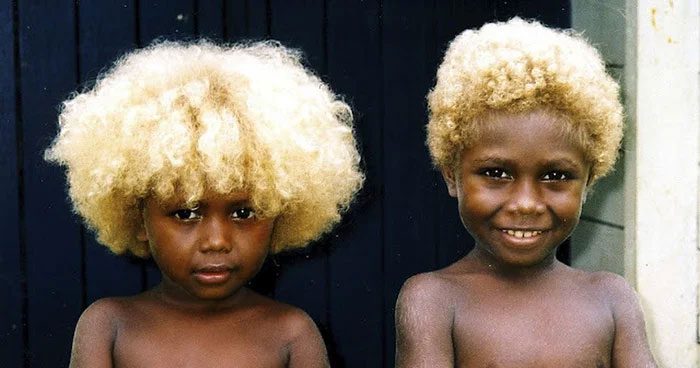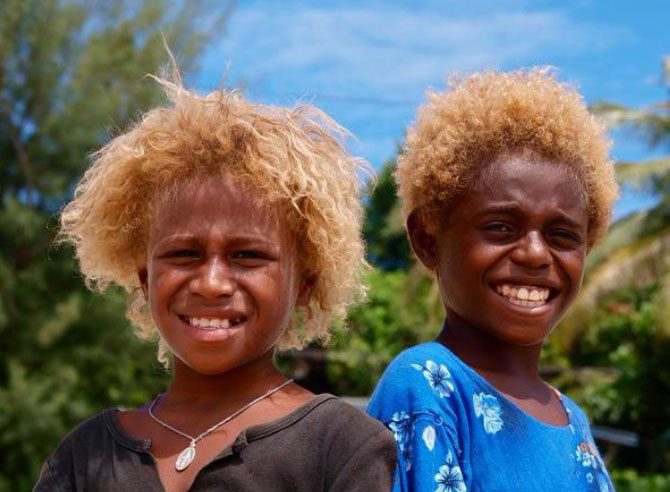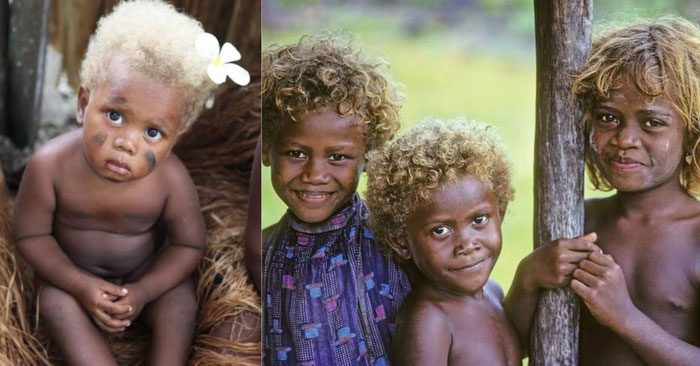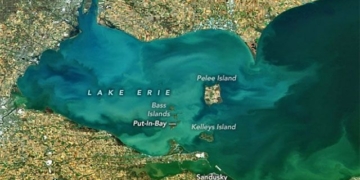Similar to indigenous Asians, Black individuals typically have black hair; however, there are exceptions, particularly among the Melanesians, who are considered the only group on the planet with naturally occurring blonde hair.
Blonde hair is usually associated with Caucasians of European descent. However, certain populations with darker skin still exhibit natural blonde hair. They are referred to as “Melanesians.”
Jules Dumont D’Urville, a French explorer and naval officer who explored the South and West Pacific, Australia, New Zealand, and Antarctica, first coined the term “Melanesia” in 1832 to refer to a specific set of islands distinct from Micronesia and Polynesia.
The indigenous Melanesians inhabit a chain of islands northeast of Australia and can be found in countries such as Fiji, Papua New Guinea, New Caledonia, and the Solomon Islands (all part of the Melanesian archipelago). Their natural blonde hair and dark skin make Melanesians stand out among other ethnic groups.
According to statistics from Historyofyesterday, between 5 to 10% of indigenous Melanesians possess blonde hair. The origins of the blonde hair among Melanesians have thus become the subject of various scientific hypotheses over the years.

A gene variant accounts for half of the hair color variation among the local population, as explained in a recent scientific article published in the journal Science. Surprisingly, this gene variant appears to have arisen in the Pacific region rather than originating from intermarriage between Europeans and island inhabitants.
Many hypotheses have suggested that their blonde hair comes from a European gene source. It is possible that in the past, blonde European traders arrived here, stayed, and had children with the indigenous people. However, as scientific research has advanced, this hypothesis has been dismissed by the scientific community. Further studies have indicated that genetic mutation is the cause of this unique phenomenon.

Blonde individuals in the Solomon Islands do not have blue eyes like Europeans. The gene that produces blue eyes originated from a single ancestor living 6,000 to 10,000 years ago. Before that time, no one had blue eyes.
In fact, Melanesians are a multi-ethnic group living in the Melanesia region of the Western Pacific. The name “Melanesian” refers to the dark skin of the indigenous people in the area and derives from the Greek term “melas”, meaning “black,” and “nesia”, meaning “island.”
Melanesians have a rich cultural heritage passed down through generations in the form of various traditional customs and beliefs. Their subsistence agriculture relies on crops such as taro, yam, and sweet potatoes to sustain themselves. Alongside traditional music, dance, and art, Melanesian culture is also known for its rituals, ancestor worship, and fishing festivals.

The TYRP1 gene mutation is not found in the gene pool of Europeans when compared to the genetic analysis results of 52 communities around the world conducted previously. Instead, this gene variant appears to have emerged independently and exists within the Melanesian community.
Further research has also indicated that there is a specific gene mutation that gives individuals from the Solomon Islands their blonde hair. Moreover, their gene mutation is entirely distinct and not present in the European gene pool.
Researchers collected saliva samples from 43 blonde individuals and 42 black-haired individuals in the archipelago to analyze the genes behind this unusual hair color.
The results showed that a gene named TYRP1 on the 9th chromosome of the 23 pairs of chromosomes in humans is responsible for 46.4% of the hair color variation among the island’s residents. This gene variant affects an enzyme involved in human pigmentation.
Sean Myles, a geneticist from Nova Scotia Agricultural College in Canada, also discovered that those with blonde hair here carry the TYRP1 gene mutation after conducting a genetic study on hair and saliva samples from 1,209 Melanesians from the Solomon Islands.
Meanwhile, this gene mutation is not present in Caucasians. Instead, this mutation seems to have emerged independently and exists within the Melanesian community. Furthermore, TYRP1 is also more commonly found in younger individuals, and because it is a recessive gene, this blonde hair may darken as children grow up and become adults. In addition to younger individuals, older Melanesian women also have blonde hair.
| Typically, our hair darkens due to an increase in eumelanin as we age (until the hair begins to gray). And since some genes do not activate until stimulated by hormones first released at puberty, perhaps our “true” natural hair color does not appear until adolescence. Hair is not the only natural trait that changes color as you age – approximately 10-15% of the population also experiences changes in eye color. |


















































